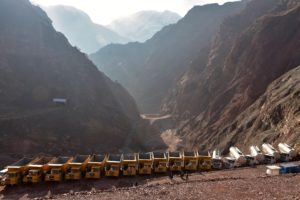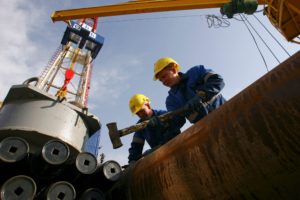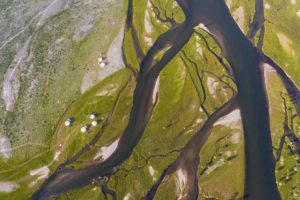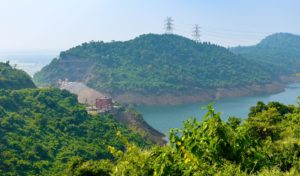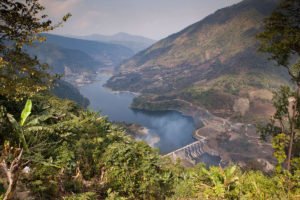The hydropower industry model in Central Asia is broken. This month, the Business & Human Rights Resource Centre (BHRRC) published new research compiled over the past decade from Central Asia and the Caucasus, revealing that negative impacts on human rights and the environment are rife in hydropower projects. Our findings also show apparent impunity among the companies and investors behind them.
A note on methodology
The BHRRC focused on Tajikistan, Kyrgyzstan, Armenia and Georgia for this research due to their geographical importance, particularly as upstream countries in Central Asia and the Caucasus. Their use and management of rivers has a significant impact on water access and other environmental factors across the region.
Between 2012 and 2022, the BHRRC has recorded allegations of more than 90 incidents of human rights abuse and damage to the environment in just 13 hydropower projects in Tajikistan and Kyrgyzstan. Harm to local communities, both in terms of public health and safety and socio-economic impacts, was one of the most commonly recorded impacts, as well as worrying reports regarding governance, transparency and labour rights.
These numbers may seem modest, but they only account for issues that have been reported publicly by civil society and the media. Many more incidents are likely to have occurred, meaning our findings are likely just the tip of the iceberg. Additionally, as the output of older infrastructure declines, more hydropower plants are planned in the region, suggesting that if current models persist, the environmental and human rights impacts of hydropower in Central Asia are likely to grow.
Persistent abuse in hydropower in Tajikistan and Kyrgyzstan
Central Asia faces huge problems around corruption and lack of access to information. And as most hydropower plants in Tajikistan and Kyrgyzstan are state-owned, and access to information is hindered, it is difficult to paint an accurate picture of the true human and environmental costs of hydropower in the region.
But we know enough to conclude that hydropower projects have had a detrimental impact on local communities. We know hydropower projects have negatively affected the quality and quantity of water in rivers, reducing access to safe water for communities and, in turn, their rights to livelihood, food and health. We also tracked problems created by mismanagement of the plants, which result in power outages, leaving populations without electricity and heat.
Our findings are likely just the tip of the iceberg
Furthermore, Central Asia’s hydropower plants are plagued by allegations regarding labour rights. We recorded one allegation of non-payment of wages and three of inadequate occupational health and safety in Tajikistan (including nine work-related deaths and 15 work-related injuries), while in Kyrgyzstan we recorded nine allegations of inadequate occupational health and safety (including one allegation of a work-related death).
Tajikistan is heavily reliant on hydropower. It is the country’s main source of energy, accounting for more than 90% of installed electricity generation capacity. Once it is completed, the Rogun hydropower plant in Tajikistan is expected to become Central Asia’s largest hydropower plant since the Soviet era. However, over the long course of its stop-start construction the plant has been linked to alarming human rights issues.
In 2010, a lack of funds resulted in local communities being forced to buy shares in the Rogun dam. Threatened with losing their jobs, some reportedly spent as much as half their salaries. In addition, approximately 42,000 people were resettled because of the project. After resettlement, their standard of living deteriorated due to loss of land, lack of employment and poor access to essential services such as water and schools in their new settlements. Meanwhile, the homes of those who weren’t resettled were damaged by the vibrations caused by construction work. Those working on the site also have faced instances of non-payment of wages.
Furthermore, there have been allegations of misuse of funds and “illegal trafficking” of materials intended for the Rogun hydropower plant. Local experts attributed a crack which appeared in the dam in 2019 to use of low-quality building materials, and warned of further issues in the future (this was denied by the plant’s administration). A 2016 audit of the project also revealed financial improprieties of a total of USD 19.7 milllion.
Kyrgyzstan, like Tajikistan, uses its rivers to generate 90% of its energy through hydropower.
Kyrgyzstan’s Toktogul hydropower plant provides an estimated 40% of the country’s electricity. But due to major droughts in 2021, critically low water levels caused an electricity crisis throughout the country. Despite the impacts of this lack of water, the government released extra water from the plant’s reservoir to downstream Uzbekistan and Kyrgyzstan, under an energy trade deal with the neighbouring countries, exacerbating the power crisis. Power restrictions were enforced, which often left the population in complete darkness.
There has been a gradual annual decrease in water levels in the Toktogul reservoir in recent years – a stark warning of the impact the climate crisis is having on the country’s water supply. Yet the government’s response to declining output of the Toktogul plant has been to plan dozens of smaller hydropower projects.
Investors pump money into hydropower
Despite these significant issues, international financial institutions continue to pump money into hydropower in Central Asia. In some cases, they invest directly in the operations of hydropower projects that face allegations of serious human rights and environmental harm.
Despite the allegations reported around the Rogun hydropower project, Tajikistan continues to search for investors and was in discussions with the European Bank for Reconstruction and Development as recently as 2021. Earlier this month, news appeared that the EU is considering investing in Rogun through its lending arm, the European Investment Bank, to help Central Asia cut its reliance on Russian energy as well as in response to China’s Belt and Road Initiative.
Editor’s note
The BHRRC contacted all companies involved in this research, inviting them to respond to the allegations. International financial institutions were invited to respond to the allegations following the publication of the report.
Meanwhile, the Eurasian Development Bank is investing in the Kambarata-2 hydropower plant in Kyrgyzstan, which is facing allegations of financial fraud, as well as allegations that no proper seismic risk assessment was made of the area, potentially risking the safety of the project and nearby communities.
Many hydropower plants in Central Asia have been in operation since Soviet times. Now, international financial institutions such as the Asian Development Bank and the Eurasian Development Bank are financing their rehabilitation. None of the investee companies has a human rights policy in place. This, combined with compiled cases of human rights violations and lack of transparency, makes the involvement of financial institutions worrisome and even complicit in recorded violations.
These international institutions and development banks have human rights responsibilities. These are set out in both their own standards and international standards in the UN Guiding Principles on Business and Human Rights. The financing of irresponsible or harmful hydropower projects is a clear failure on their part to uphold these responsibilities.
Investors need to start insisting companies develop robust human rights policy and practice
Investors, financial institutions and companies must ensure protection of human rights and environmental due diligence for every project they are linked to. Strong community and worker engagement would allow them to accurately identify risks to human rights and environmental health in their operations and supply chains. Without this, they will be unable to mitigate any harms they are causing. Investors need to start insisting that companies develop robust human rights policy and practice, with rigorous reporting standards and transparency.
We all want and need a just and quick transition to net zero. But the current hydropower model isn’t working in Central Asia. It is time for companies and investors in this sector to own up to their social responsibilities.
